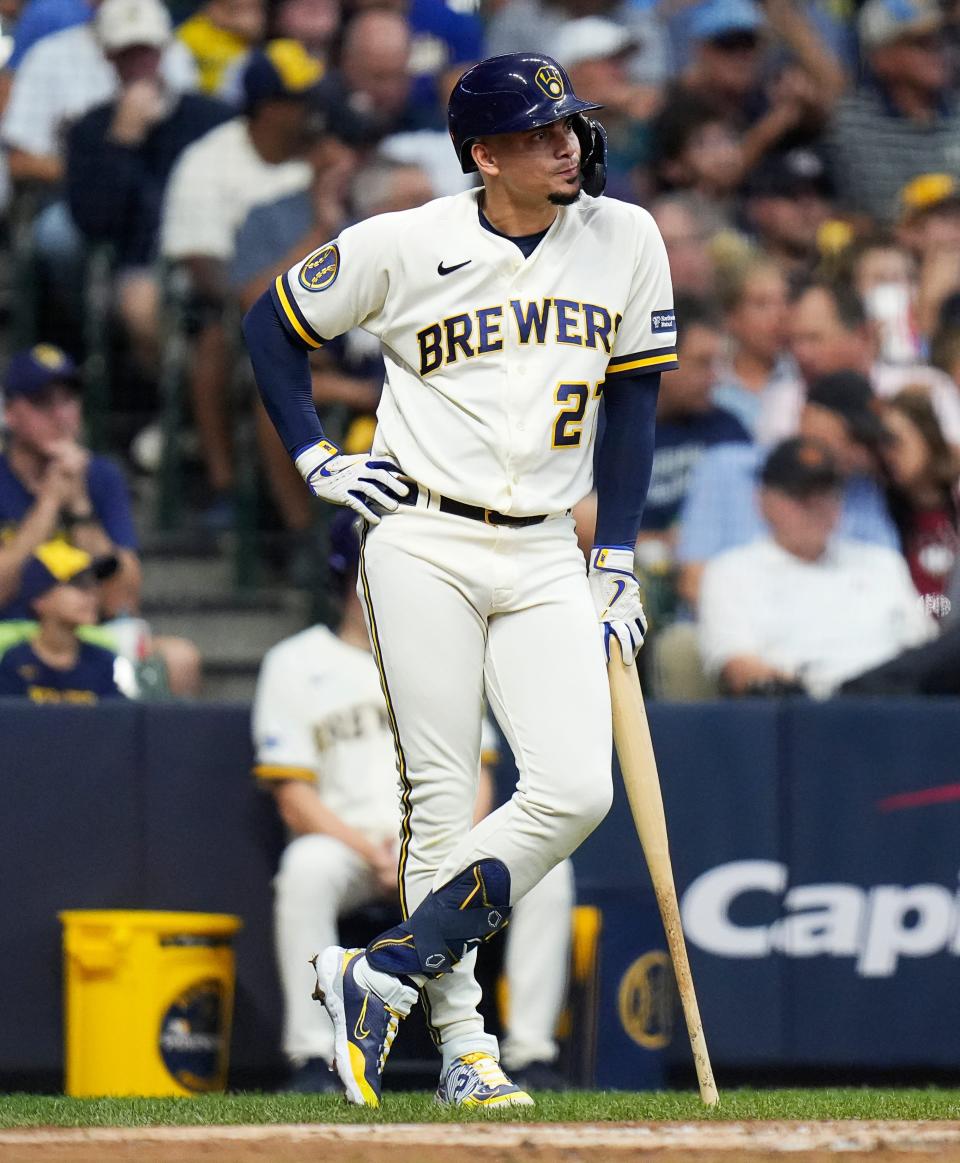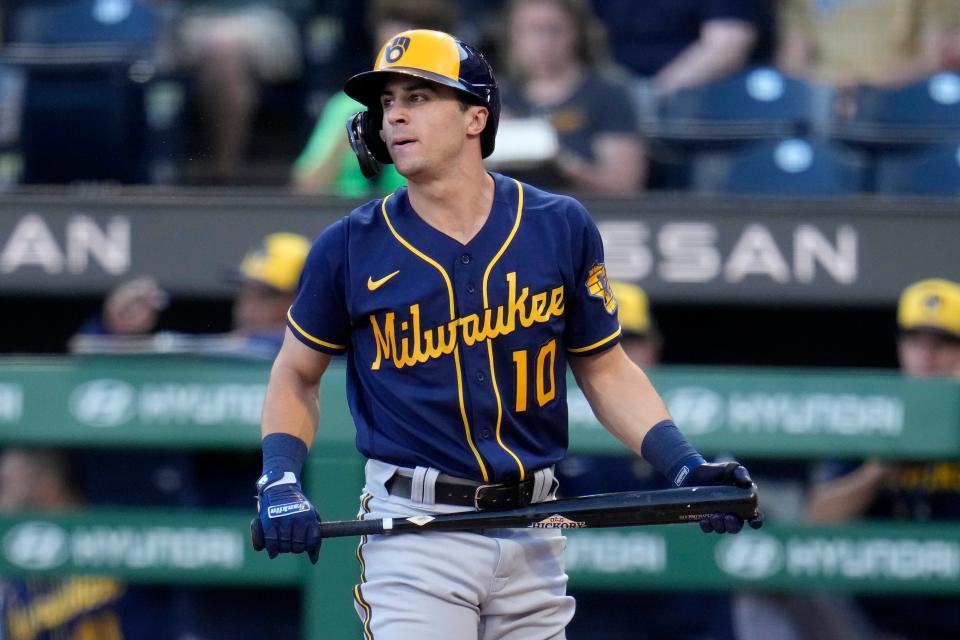This one approach change could lead to a better offense for the Brewers in 2024
Cover a baseball team for 162 games and you start to pick up on small trends.
On the Milwaukee Brewers, that could be how Wade Miley was in full uniform on days he pitched well over four hours before the game started, or how Devin Williams would sometimes have coach Quintin Berry hit him grounders at shortstop in pregame, or the little black notebook Victor Caratini always carried around that probably contained all the team's most highly classified secrets (or something like that).
Some of the trends involve the on-field action, too. With the offseason about halfway complete now, we will take a look over the rest of the week at different trends that could play a major role for the 2024 Brewers.
To kick it off, we'll look at an overarching concern with the Milwaukee offense from last season: The Brewers were too passive in spots that called for aggression.

Brewers watched more opportunities go by than any other team
Major-league pitchers rarely make mistakes, but that doesn’t mean they’re perfect. On average, a team will see 11 pitches right down the middle per game. Baseball isn’t an IKEA food market; meatballs are a scarce commodity. When you get one, you're usually best off swinging at it – it’s probably the best pitch to hit that your team will see all inning.
No team kept the bat on the shoulder for pitches right down the middle of the plate more often than the Brewers last season, though.
The Brewers watched as more than one-quarter of middle-middle pitches went by in 2023 (it was 26.7% to be exact) according to Baseball Savant, the highest rate in the majors.
On middle-middle fastballs, their take rate of 26.8% was second-highest of any team.
You can tell we've reached the second full week of the off-season because I've started doing insane things like plotting what Brewers hitters did on middle-middle pitches.
(The takeaway: They probably could've been more aggressive) pic.twitter.com/kOlpI38OmG— Curt Hogg (@CyrtHogg) October 17, 2023
Now, there’s more than one way to build a good offense. Having a high rate of aggression against pitchers’ mistakes doesn’t always guarantee overall offensive success, either.
But if you’re looking for an optimal building block to serve as a base for a team that hits well, selective pitch aggression is a strong place to start. The top four teams by wRC+ (weighted runs created plus) last year – the Braves, Dodgers, Rays and Rangers – all ranked in the top eight in swing rate on pitches down the middle.
If you break down the numbers on a count-by-count basis, the Brewers still were quite passive in hitters’ counts, too. On the first pitch or when ahead in the count, Milwaukee batters took 37% of pitches down the middle overall and 34.2% of fastballs. Only two teams took pitches in those situations at a higher rate.
Brewers lineup was constructed with lots of patience
Part of the reason the numbers were this way for the Brewers is that their offense was built around patient hitters.
Of players to record at least 200 plate appearances last year, only Tyrone Taylor, Willy Adames and Owen Miller had a swing rate that was above the league average. As a team, the Brewers were 28th in swing rate.
The Brewers held the third-highest walk rate in MLB, which was a big reason why the offense wasn’t even lower in total offense ranks. It’s hard to knock their patient approach too much considering drawing walks was an area in which the Brewers offense truly excelled.
But while discipline is important, damage is even better.
If, even with the third-best walk rate the Brewers couldn’t piece together an offense ranking better than 24th in wRC+, perhaps some of that patience would have been better off being traded for some big, aggressive hacks in advantageous spots.
After all, only four teams in the majors saw more pitches while ahead in the count.
Yet even though Brewers hitters earned themselves advantageous counts more often than almost anyone, they didn’t always capitalize on the legwork that got them to that point.
It’s not just pitches down the middle, either
Let's broaden the horizon a little since pitches exactly over the middle make up only a small percentage of total pitches thrown and aren't the only good pitches to hit.
If you’re taking the best of the best pitches to hit, you probably also aren’t swinging at a ton in general, and this was certainly true of the Brewers. Their swing rate at fastballs anywhere in the strike zone in any count was the second-lowest (63.2%), and in 2-0 or 3-1 counts was only a tad higher (63.9%).
Those two counts are at the top of the list of best opportunities a hitter will get to sit dead-red on a fastball; the league slugged .627 in a 2-0 count and .637 in a 3-1 count. The leaguewide slugging percentage goes up to .660 on fastballs in those counts.
The Brewers, when they swung, were right around league-average in this area (.653 slugging percentage), but it’s not the opportunities that they took that hindered them. Rather, it was the ones they didn’t take.
In at-bats in which they took a fastball for a strike ahead either 2-0 or 3-1, they wound up hitting just .220 with a .310 slugging percentage, nine doubles and two home runs. In terms of doing damage, they as a team effectively turned into Jose Caballero after putting themselves into an advantageous spot and getting a pitch to hit ... but then not swinging at it.
Now, part of the tradeoff of not swinging as much is that you’re more likely to have a longer plate appearance and possibly draw a walk. The Brewers did exactly this. They generated a .462 on-base percentage in plate appearances in which they took a 2-0 or 3-1 fastball strike, which is quite good.
Yet that level of on-base production probably still wasn't worth it, in part because the Brewers also still struck out in nearly of a quarter of those situations. Add in the .310 slugging percentage in those spots and you get a .772 OPS (on-base percentage plus slugging percentage) after taking hitters-count heaters. The league average OPS when those pitches get put into play is 1.031.
By trading aggression for patience, the Brewers gained some additional OBP over expected to the offense, but it came at the cost of significant slugging potential. In the end, it was a net loss and potentially a big one of roughly 250 points of expected OPS across roughly 250 total plate appearances in a season.

Returning offense
Of course, the 2023 season is long over. The Brewers can’t go back and try to improve on an offense that had a .704 OPS.
But they can take steps forward with the 2024 offense, which might look for the most part very similar to how it did in the final months of last season.
Christian Yelich, William Contreras, Sal Frelick, Willy Adames, Brice Turang, Andruw Monasterio, Garrett Mitchell, Owen Miller and Joey Wiemer are all still on the roster after playing key roles last year. Those players accounted for nearly two-thirds of the team’s plate appearances in 2023.
The Brewers had only four players swing at middle-middle fastballs when ahead in the count more often than league average, and just one of those – Yelich – is back next year. Of the anticipated returners, Frelick had the lowest rate at 47.8%, followed by Miller and Blake Perkins.
If the Brewers are to be more aggressive with hittable pitches in 2024, it’s likely going to be because those players altered their approach.
Increased output from the offense is paramount to Milwaukee’s success in 2024. A more assertive approach in hitter-friendly situations isn’t going to single handedly revitalize the offense, but it sure might help.
This article originally appeared on Milwaukee Journal Sentinel: Brewers offense could benefit from attacking more often in 2024

